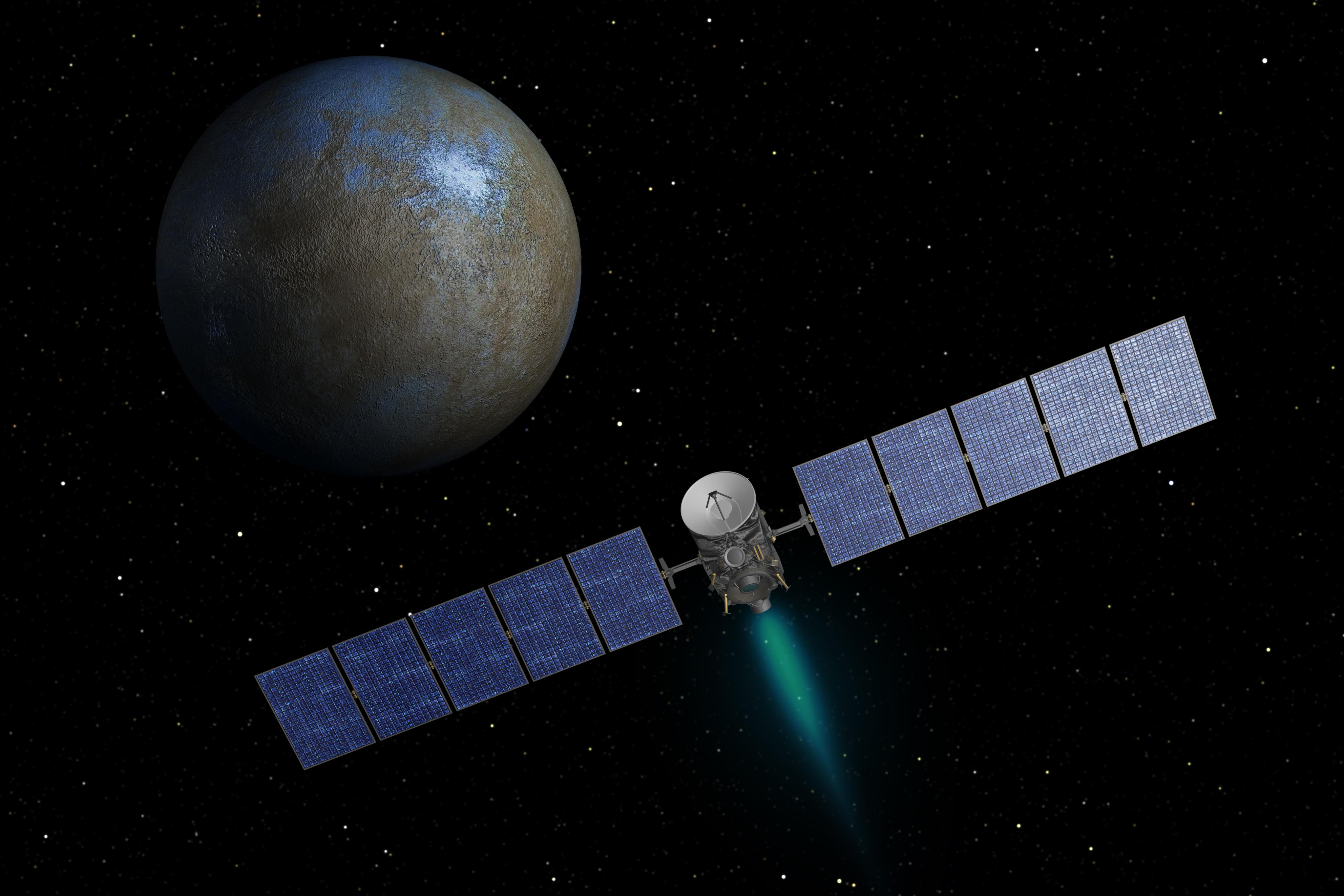
“I’m ecstatic,” said Sarah Gavit of NASA’s Jet Propulsion Laboratory (JPL) in December 2001, when the space agency announced that the Dawn mission to orbit and explore the dwarf planets Ceres and Vesta—a pair of worlds deep within the asteroid belt, between Mars and Jupiter—was to go ahead. Earlier that year, Dawn had been selected, alongside a concept to examine Jupiter’s internal structure and the Kepler space telescope as the next members of NASA’s medium-cost Discovery program. “Ceres and Vesta are two of the large unexplored worlds in our Solar System,” Gavit continued. “We’ll learn about early planet formation in ways that wouldn’t have been possible before this mission.”
However, Dawn’s mission, which eventually rose from Earth a decade ago, on 27 September 2007, would be twice canceled before being reinstated to become humanity’s first-ever mission to visit a single dwarf planet, much less orbit as many as two extraterrestrial bodies. As NASA’s first exploratory voyage to utilize ion propulsion, Dawn’s JPL-built trio of xenon-ion thrusters would accomplish a remarkable feat of celestial mechanics, pushing the spacecraft across 1.9 billion miles (3 billion km) to reach Vesta in July 2011, circling it for more than a year, then setting off again in September 2012 on a 30-month trek to Ceres, in whose orbit it currently resides.

More than 100,000 rocky bodies are known to inhabit the asteroid belt, which provides a reservoir of material from the Solar System’s formation, more than 4.6 billion years ago. Not only are Ceres and Vesta two of the largest, but they are also quite different from one another: the former was thought to possess an ice-rich composition, with the latter decidedly more ‘rocky’. Their exploration was expected to reveal important clues about the formation of bodies of ice and rock in the distant Solar System and under what specific conditions they can harbor reserves of water.
Managed by JPL, the Dawn mission also featured international participation from European partners in the Netherlands, Italy and Germany. Its scientific payload included a framing camera—capable of resolutions as fine as 56 feet (17 meters) per pixel at Vesta and 216.5 feet (66 meters) per pixel at Ceres—together with a visible and infrared spectrometer and a gamma-ray and neutron detector. The spacecraft itself measures 65 feet (19.7 meters) in length, when its solar arrays are fully deployed, and initially targeted a June 2006 launch. Dawn would perform a flyby of Mars in early 2009, receiving a gravity-assisted boost to reach Vesta in fall 2011 for a minimum six-month orbital stay, before navigating a path to Ceres, which it would encounter in August 2015.
Sadly, the realities of cost, mass, power requirements and overall complexity conspired against the mission and it found its launch date correspondingly move to the right, firstly settling on November 2006 and eventually June 2007. All was clearly not well and in March 2006, NASA canceled Dawn, whose costs had spiraled from $373 million to over $446 million. Yet a white knight in the form of new management procedures established by then-NASA Administrator Michael Griffin “saved” Dawn and it was restored to full flight readiness later that same month. In April 2007, the 2,680-pound (1,210 kg) spacecraft arrived at Cape Canaveral Air Force Station, Fla., for final closeout and processing, ahead of launch, atop a United Launch Alliance (ULA) Delta II. The rocket would fly in its “7925 Heavy” configuration, equipped with nine strap-on boosters, capable of delivering a payload ten times more massive than the “barebones” Delta II.

The gremlins were not yet done with Dawn, however. Delays to parts deliveries, followed by a broken crane at Space Launch Complex (SLC)-17B and weather and range-related issues pushed the launch past the second half of July. With NASA’s Phoenix mission to Mars aiming for a tight “window” in early August, Dawn’s own launch was postponed until the end of September. Dawn finally rose from Earth at 7:34 a.m. EDT on 27 September—ten years ago, today—and was placed into an Earth-escape trajectory by the Delta II. Following a two-month checkout of its xenon-ion thrusters and other systems, the spacecraft began its interplanetary cruise shortly before Christmas and in February 2009 swept within 341 miles (549 km) of Mars, picking up a gravitational boost to encounter Vesta.
It entered the asteroid belt to stay in November 2009 and as its thrusters continued to pulse, it eclipsed the record set by the 1998-launched Deep Space-1 mission for the greatest amount of velocity change afforded by a spacecraft’s engines, passing 9,600 mph (15,450 km/h). As the rendezvous with Vesta neared, Dawn’s three scientific instruments were brought online in March 2011 and on 3 May the spacecraft captured its first photographic view of the pearl-like dwarf planet, from a distance of 752,000 miles (1.2 million kilometres). “After plying the seas of space for more than a billion miles,” gushed Carol Raymond, deputy principal investigator for the mission, “the Dawn team finally spotted its target.”
For a spacecraft named for the first appearance of light in the early-morning sky—or, on a metaphorical level, the perception of understanding of new knowledge to the mind—Dawn was figuratively and literally shedding a wake-up glow to humanity’s understanding of its place in the cosmos. Over the next half-decade, the ancient, crater-pitted worlds of Vesta and Ceres would be extensively scrutinized, revealing these primordial bodies to be key players and a lasting record of the evolution of the Solar System.
To commemorate Dawn’s ten-year anniversary, AmericaSpace will look back at the scientific bonanza from Vesta and Ceres in a history article on Sunday.
Be sure to “LIKE” AmericaSpace on Facebook and follow us on Instagram & Twitter!





